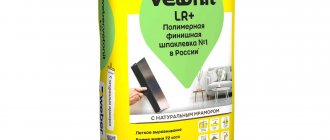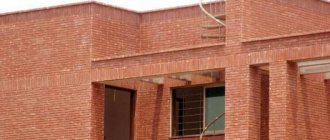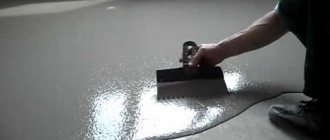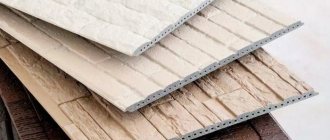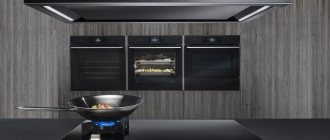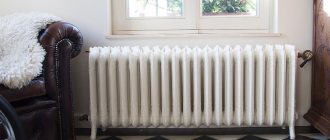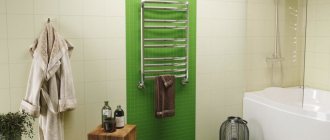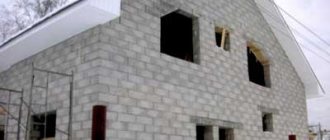Expanded clay concrete blocks occupy an intermediate place between brick and porous blocks of foam and aerated concrete.
They inherited strength and frost resistance from brick. They can be compared with lightweight concrete due to their large dimensions, low thermal conductivity and low weight.
The production of expanded clay concrete blocks involves adding expanded clay gravel with a fraction of 5–10 mm and coarse expanded clay sand to the cement mortar. The energy-saving characteristics of the block and its strength directly depend on the size of the filler. The larger the gravel that is added to the molding mass, the warmer but less durable the expanded clay blocks are.
Let's take a closer look at the technical characteristics of this material in order to have a good idea of its capabilities, advantages and disadvantages.
Specifications
The construction standard provides for the following dimensions of expanded clay concrete blocks: 188x190x390 mm and 188x90x390 mm with a maximum permissible deviation from the specified dimensions of 10-20 mm. The first standard size is wall blocks, the second is partition blocks.
Dimensions of a standard expanded clay wall block
Depending on the quality of the surface of the side faces, expanded clay blocks are divided into ordinary and front. Ordinary ones are intended for laying walls, additionally protected by external decoration. Facing blocks allow the construction of a building without subsequent treatment of the facade with finishing compounds or tile materials.
Partition block made of expanded clay concrete
Another important detail related to the characteristics of this material is the presence of voids. A hollow block has through or non-through vertical voids. They reduce the weight of the material and increase its energy-saving qualities. Solid blocks, on the contrary, are heavier and more durable. They are used for laying capital walls that can withstand high loads.
Blocks for building a house - which ones are better?
For the needs of private housing construction, the following materials can be used:
- modules made of cellular concrete (foam concrete/aerated concrete/gas silicate);
- expanded clay concrete blocks;
- cinder blocks;
- sawdust concrete and wood concrete;
- polystyrene concrete blocks.
In order for concrete to maintain the specified fire resistance, when combined with other building materials, all connecting nodes must be protected from fire.
When choosing, you should focus on design data and actual construction conditions, since none of the presented materials can be called universal. For example, what kind of foam block is recommended to use for the construction of a house whose height does not exceed two floors, and expanded clay concrete is more durable and allows you to design a building with a higher number of storeys , but is inferior to cinder block in terms of water permeability.
Density and strength
These are the most important technical characteristics of expanded clay concrete blocks, since energy-saving and acoustic properties depend on density, and the reliability of load-bearing walls of a building depends on strength.
The density of this wall material depends on the filler fraction and varies over a wide range (from 500 to 1800 kg/m3).
The strength of expanded clay blocks ranges from B3.5–B20, which in terms of the static load is from 35 to 250 kg/cm2. The weight of the blocks ranges from 10 to 23 kg. The durability of this material reaches 60 years.
The optimal ratio of thermal conductivity and block strength is achieved by using suitable clay for the production of expanded clay of the required density and fresh high-quality cement M500. Here is an example of the qualitative proportion of expanded clay concrete blocks produced by the Cheboksary Construction Plant.
Standard, thick and solid block
Production Features
Scheme of production of expanded clay concrete blocks on a special installation.
Expanded clay blocks are produced using a special technology, which consists of semi-dry pressing of the initial mixture, during which low-frequency vibration is ensured. As a result of vibration laying under pressure, particles of cement and expanded clay in water are formed into a dense, homogeneous structure. After this forming and compaction, the block elements are sent to the drying chamber.
Quite good results are obtained when the mass hardens under natural conditions. However, in mass production, workpieces are heated by infrared rays or a hot jet. The expanded clay concrete block achieves its final strength parameters after remaining on warehouse racks for 28 days.
Energy saving
A very important parameter for any masonry material is thermal conductivity. For expanded clay blocks it strictly depends on the density.
| Density, kg/m3 | Thermal conductivity coefficient, W/(mS) |
| 1800 | 0,81–0,90 |
| 1600 | 0,66–0,78 |
| 1400 | 0,57–0,64 |
| 1200 | 0,45–0,53 |
| 1000 | 0,32–0,42 |
| 800 | 0,25–0,32 |
| 600 | 0,21–0,27 |
| 500 | 0,18–0,24 |
For easier orientation in the purpose of blocks, builders use the concept of structural, thermal insulation and structural material. Expanded clay blocks with a volume weight from 600 to 1100 kg/m3 are classified as the first type, and with a material density from 1200 to 1800 kg/m3 - to the second.
The most common dimensions
Most often during operation, blocks with the following parameters are used: 39 * 19 * 18.8 cm. This is very convenient, for the reason that in the central zone of the Russian Federation the ideal wall thickness is considered to be exactly 40 cm. This information means that it is best to carry out masonry in one or two block. When creating walls between rooms, they build a wall with a smaller thickness - 9 cm. This means that walls made of lightweight concrete for rooms should have similar characteristics: 390 * 90 * 188 mm. True, this information does not mean that an interior wall cannot be made from a shorter or longer panel. They also build this way, but they use shorter ones - there will be a higher consumption of cement, and longer slabs will be heavier.
Frost resistance and fire resistance
The durability and load-bearing capacity of walls depends on the frost resistance of expanded clay concrete. For expanded clay blocks, GOST has established several frost resistance grades: F25, F35, F50 and F75. The numbers here indicate the number of freezing and thawing cycles that a block completely saturated with water can withstand without loss of strength.
Expanded clay blocks have the highest fire safety class - A1. This means that the action of an open flame does not destroy the masonry for 7–10 hours.
Vapor permeability
An important environmental parameter that today is carefully studied not only by professional builders, but also by ordinary developers. Expanded clay concrete is a breathable material, as confirmed by the table below.
| Density, kg/m3 | Vapor permeability, mg/(m h Pa) |
| 1400 | 0,094 |
| 1200 | 0,108 |
| 1000 | 0,138 |
| 800 | 0,187 |
| 600 | 0,256 |
To an inexperienced person, these numbers will mean little. The builder will see in them that expanded clay concrete “breathes” 2 times better than brick and is almost as good as wood and plasterboard in terms of vapor permeability.
In addition, expanded clay block has the ability to absorb excess moisture from the air and release it at low humidity in the room. Therefore, in a house built from this material, even without the use of forced ventilation, a comfortable microclimate is established.
Ideal for temperate climates
In the case where you want to build a home, the best solution would be to order a project. Here everything will be taken into account, every unit, material, as well as the size of the blocks, their recommended parameters and quantity. You just need to purchase everything that is indicated on the list. However, not everyone does this. There are costs for the project, but there is no money for the project. And people are trying to figure it out on their own in the absence of any accurate calculations. One can also understand this point of view, but there is no fact that it will save resources, for the reason that they create this with strength reserves, and construction materials are consumed in excess.
– No insulation required. The best wall thickness is 600 mm. Volumes for the block are 590*290*200 mm, ordinary building material, structural and thermal insulation type. We recommend placing the masonry with the slot voids facing up and filling them with thermal insulation. Expanded polystyrene crumbs are the best option. It is better to finish the inside with plasterboard and the outside of the house with plaster.
Examples of laying expanded clay blocks
– 500mm, large in width, without insulation. Here it is important to select the dimensions; often the block will be manufactured with non-standard parameters and non-standard dimensions. Often in the markets you can find blocks 50 cm long and 24 cm wide. Masonry is usually done using a standard dressing scheme, this is the most convenient. You can also use other options, but you will have to develop a diagram for the masonry system yourself.
Another popular solution is with brick cladding.
– Expanded clay structure, consisting of a 290 mm block using insulation. It is necessary to use blocks with a large format when using a similar format for constructing buildings. According to GOST, their size should be 288*288*138 mm, however, such blocks complicate the work due to their heavy weight. They also use narrower ones: the width is 138 mm, thanks to which it is possible to achieve the required thickness. About 10 cm of thermal insulation is required, and the inside is finished with plaster or plasterboard. In a situation with the choice of expanded clay blocks, it is important to pay attention to two situations: it is necessary that the strength class of the block is not lower than B3.0. Another important parameter is that it is best if the thermal conductivity of the block is as low as possible.
Marking
All the most important technical parameters of expanded clay blocks can be found out from the abbreviated designation with which the manufacturer labels its products.
The first letter K indicates that this material belongs to the category of artificial stone.
The second and third carry information about the scope and purpose:
- C - wall;
- P - septal;
- L - facial;
- R - ordinary (for finishing).
The fourth and fifth letters specify the purpose of the block in the masonry: UG - corner, PR - serial, PZ - for dressing seams. The hollow block is marked with the letters PS. Further, the marking indicates the length of the block (39 cm).
Then come the grades of strength, frost resistance and density. Knowing this simple algorithm, you can easily read the most important information about the material. For example, we will decipher the marking of the block KSL-PR-PS-39-75-F20-1200 as follows: wall stone, front stone, order stone, hollow stone. Its length is 39 cm, compressive strength 75 kg/cm2, frost resistance 20 cycles and density 1200 kg/m3.
Advantages and disadvantages
As we have already said, expanded clay blocks according to GOST are made without the use of toxic synthetic resins and other additives harmful to health.
In addition to good vapor permeability, their advantages include:
- Durability.
- Strength.
- Light weight and low labor costs for masonry (large block format).
- Low thermal conductivity.
- Possibility to use the main load-bearing material of the walls (concrete, sand-lime brick) as additional thermal insulation.
- Fire resistance and absence of toxic combustion products during thermal decomposition.
- Good compatibility of masonry with different types of facing materials (tiles, ordinary and decorative plaster, wood).
- A smooth surface allows you to reduce the consumption of finishing solution.
- Affordable price.
Minuses:
- They do not tolerate dynamic and shock loads well.
- Due to its high abrasive qualities, it is difficult to saw and cut, forming uneven edges with cracks.
Comparing the pros and cons of expanded clay concrete blocks, it is easy to notice that they have more positive qualities than negative ones. Therefore, reviews of this material are mostly positive.
When purchasing such blocks, you should pay attention to this point: some manufacturers, in an effort to save on cement, add organic and synthetic adhesive additives to the initial solution. They worsen the environmental characteristics of the material. Therefore, before you buy expanded clay blocks, you should check whether the seller has a GOST certificate of conformity.
Negative sides
As follows from some reviews, expanded clay as floor soundproofing is not that good. The strength of the material is inferior to heavy concrete mortar, so it is undesirable to use such blocks for arranging the foundation.
In addition, the geometric parameters of the blocks leave much to be desired.
When constructing objects with a large number of floors, blocks containing a lot of cement composition should be used. Because of this, it will be necessary to pour a more powerful foundation, which will deteriorate the thermal insulation properties of the object, and there will be a general increase in the cost of design work.
Approximate prices
When planning to build a house from expanded clay concrete blocks, you should clearly understand the prices for this material. Manufacturers indicate its cost not only in rubles per 1 m3, but also per 1 piece.
It’s not difficult to understand different prices if you use a simple translation algorithm: 1 m3 contains 72 blocks of standard size (188x190x390 mm).
The average cost of one hollow wall block made of expanded clay concrete is from 40 to 54 rubles (1 m3 - 2900-3800 rubles)
They offer to buy a solid full-size block at a price of 52 to 65 rubles (price per cube is 3700 - 4600 rubles)
The price of a hollow partition block ranges from 32 to 34 rubles per piece. Unlike full-size ones, when sold, these blocks are measured not in cubic meters, but in “squares”. The cost of 1 m2 (13 blocks) ranges from 416 to 450 rubles.
More about sound insulation
Those who deal with the design of construction projects are constantly faced with the peculiarity of the technical specifications from the customer, which stipulates the issue of sound insulation of the room. For some reason, private developers do not consider this issue a priority. And in vain.
The lack of good sound insulation in rooms, especially between neighboring apartments, during the subsequent operation of the facility significantly poisons life, giving rise to conflicting relationships between family members and neighbors.
To avoid such situations, experts recommend installing a layer of expanded clay on the floor to reduce audibility. And don’t forget about the walls.
The indicators of sound insulation characteristics of enclosing structures determined by GOSTs are determined for each, taking into account their purpose on the basis of SNiP.
For a wall this value is 50 - 62 dB, for a partition - 41 - 50.
Measurements were experimentally carried out using Mayer's method using the Durgamer-Kammerer acoustic diagram, which showed that walls forty centimeters thick, made of expanded clay concrete block material, have a sound insulation value of 63.5 dB.
By purchasing such material, you will receive excellent sound insulation performance and will be able to use the room without worrying about excess noise.
